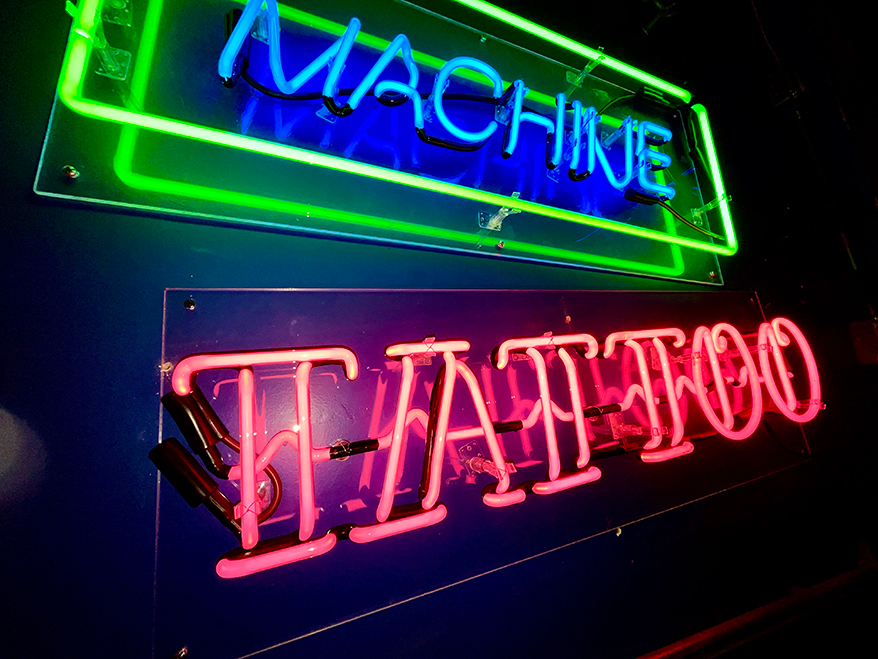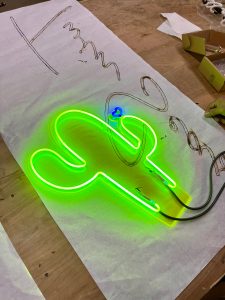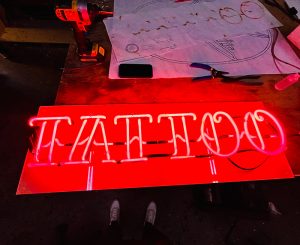HAVE YOU EVER had a headache where you find yourself checking off a list for a possible cause? Hmm … Enough water? No coffee? Food? Stress? Enough sleep? Or maybe you slept too much! Get up!
Neon sign issues are very much like random headaches. Different causes can result in the same outcome. For example, the notorious neon buzzing sound. I love that sound and so does the entertainment industry. It’s been used time and time again to represent neon — so often, in fact, that many of us unconsciously associate the buzz with neon and even consider it normal. But let’s face the facts: It’s only cool to hear in a movie or on the radio for about three seconds. Imagine hearing it for a full shift. Torture! A buzzing neon sign actually indicates that something’s wrong. Let’s make a list of probable causes.
The most common culprit is the neon transformer. It’s possible that the transformer is either too old (on the verge of burning out) or overloaded. I often see hefty neon signs being powered by just one transformer. However, even if only one can light a sign, the transformer’s power is reduced by the length/amount of GTO cables and by the color and diameter of the neon tube. For example, red neon lighting typically consumes 3.5 to 4 watts per foot. When a transformer is too old or overloaded to meet that rate of consumption, the sign starts buzzing or burns out completely. The solution is to distribute the electrical load between the proper number of transformers, not only to reduce the chances of a buzz, but also to prolong the life of the sign and transformers as well.
A second cause can be an ungrounded location or an ungrounded sign. Electricity loves to travel! Always looking for somewhere to go, in most cases, it’s attracted to metal, traveling to parts like screws and metal backing structures. A simple solution is to isolate the transformer and its GTO cables as much as possible. Ensure the GTO cables have enough distance between one another and make sure your transformer is far enough from whatever is creating the buzzing sound. A sign of mine was buzzing once and the only metal parts in the sign were the chains I used to hang the sign. I figured that was the issue, so I grabbed the electrical tape and wrapped the ends of the chains. Ta-da! Buzz gone. Yes, I just might be a genius.
Another thing I’ve experienced is neon glass bends ending up too close together. This doesn’t mean you have to remake the sign from scratch immediately; first you can try putting a small piece (or pieces) of mica in between the area. Mica adds electrical resistance and will often kill the buzz.
If you’ve tried everything you can think of and still have the neon buzzing, I wouldn’t rule out a faulty electrode or faulty neon unit altogether. I’ve been defeated before and just had to remake the sign. I lost some profit but kept my sanity. Oh, and a happy client!
Advertisement
Keep in mind that neon signs are powered by high-voltage electricity. While the electricity running through a neon sign is never fully quiet, know that you shouldn’t be able to hear buzzing to an extreme, annoying level. Let’s leave the headache of buzzing where it belongs — as a three-second sound effect.
PHOTO GALLERY (4 IMAGES)
 A loud buzz coming from a neon sign is the sympton of something wrong, most likely with the transformer.
A loud buzz coming from a neon sign is the sympton of something wrong, most likely with the transformer.

 Tip Sheet3 days ago
Tip Sheet3 days ago
 Business Management1 week ago
Business Management1 week ago
 Women in Signs2 weeks ago
Women in Signs2 weeks ago
 Real Deal4 days ago
Real Deal4 days ago
 Editor's Note1 week ago
Editor's Note1 week ago
 Line Time2 weeks ago
Line Time2 weeks ago
 Product Buying + Technology1 week ago
Product Buying + Technology1 week ago
 Benchmarks11 hours ago
Benchmarks11 hours ago

















